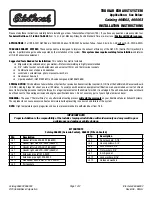
Running-in notes
The first 1,500 km
G
Risk of accident
New brake pads/linings only have optimal
braking performance after several hundred
kilometres. Until then, compensate for this by
applying greater force to the brake pedal. This
also applies when brake pads/linings or
brake discs have been changed.
If you treat the engine with sufficient care
from the very start, you will be rewarded with
excellent performance for the remainder of
the engine's life.
R
Therefore, you should drive at varying road
and engine speeds for the first 1,500 km.
R
Avoid heavy loads, e.g. driving at full throt-
tle, during this time. Do not exceed
2
/
3
of
the maximum permissible engine speed for
each gear.
R
Change gear in good time.
R
Do not shift down a gear manually in order
to brake.
R
try to avoid depressing the accelerator
pedal beyond the pressure point (kick-
down).
R
only use ranges 3, 2 or 1 for slow driving,
e.g. in mountainous terrain.
After 1,500 km, you may gradually bring the
vehicle up to full road and engine speeds.
Additional notes on running in AMG vehicles:
R
do not drive faster than 140 km/h for the
first 1,500 km.
R
only bring the engine up to a maximum
speed of 4,500 rpm for a brief period.
i
You should also observe these notes on
running in if the engine or the axle gear on
your vehicle have been replaced.
Refuelling
Refuelling
G
Risk of explosion
Fuel is highly flammable. Fire, naked flames
and smoking are therefore prohibited when
handling fuels.
Before refuelling, turn off the engine and the
auxiliary heating*.
G
Risk of injury
Avoid any contact with fuels.
You can damage your health if your skin
comes into direct contact with fuel or if you
inhale fuel vapours.
G
Risk of fire
Do not use petrol to refuel vehicles with a die-
sel engine. Never mix diesel with petrol. This
causes damage to the fuel system and engine
and could result in the vehicle catching fire.
!
Do not use petrol to refuel vehicles with a
diesel engine. Do not use diesel to refuel
vehicles with a petrol engine. Even a small
quantity of the wrong fuel will damage the
injection system. Damage resulting from
adding the wrong fuel is not covered by the
implied warranty.
!
Do not start the engine if you accidentally
refuel with the wrong fuel. Otherwise, the
fuel could enter the fuel lines. This would
require draining of the fuel tank and fuel
lines. Notify a qualified specialist workshop
and have the fuel tank and fuel lines
drained completely.
When you open or close the vehicle with the
key or KEYLESS GO*, the fuel filler flap is
automatically unlocked or locked.
The position of the fuel filler cap is to the rear
on the right. The position of the fuel filler cap
is displayed in the instrument cluster
8
.
310
Refuelling
Ope
ration
* optional
221_AKB; 2; 3, en-GB
bjanott,
Version: 2.11.7.7
2009-02-27T14:56:10+01:00 - Seite 310
Dateiname: 6515231002_buchblock.pdf; erzeugt am 03. Mar 2009 15:18:22; WK
















































